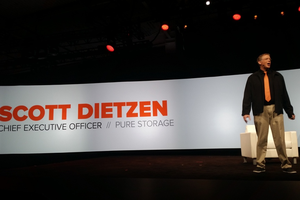Dell Releases OS 10 for the Open Networking Era
Dell has released the latest version of its networking operating system, called Operating System 10, (OS10, not to be confused with the Mac operating system OSX).
The base module is available for free, and runs a fully-open unmodified Linux distribution. The special magic is provided by the Open Compute Project's Switch Abstraction Interface (SAI) that Dell helped create, and which is being supported by big vendors like Microsoft and Broadcom. It means the base module can talk to networking specific silicon on the physical switch device, but using the open abstraction interface, rather than a silicon specific interface.
This is great for challenger manufacturers, as they can more easily access markets dominated by proprietary networking silicon vendors (*cough*Cisco*cough*). Networking software vendors–like Big Switch Networks and Cumulus Networks–also benefit, because now they can target a single interface instead of having to write code for every different vendor.
For customers, it means more competition in the the high-margin networking game which will help lower prices. It also demonstrates how networking is fast splitting into two categories: the physical hardware, or silicon, used to physically connect devices, and the logical connections between devices mediated through software.
Previously, the software used to connect devices together was tightly coupled to the hardware that network cables plugged into. We're now seeing aggressive moves to dis-aggregate the software from the hardware.
“It's a whole new degree of choice and capability,” said Jeff Baher, Executive Director, Product Marketing, Dell Networking. “It's still early […] but this looks to be the predominant way of doing things in the future in the networking market.”
“It's designed initially for pretty advanced, large scale data-center operators,” Baher says. “Over time, this will be the software base for all of our mid-market data-center, campus, and branch devices. But today, it has a special appeal for the DevOps community.”
“They like to see networking tightly aligned with servers and storage, and the way in which they write applications, and the way these applications get stitched to the network are pretty unique, and pretty advanced. Those are things that you can't do today with current networking software the way it's been delivered,” he says.
While software will always require hardware to run on, the future looks to be one where you don't have to run a vendor's software on hardware supplied by that same vendor.
It will be interesting to watch how vendors who tightly couple their software with hardware–the likes of Oracle, Cisco, and the hyperconverged crowd–respond to this de-coupling effort.
Do you have your popcorn ready?
You can listen to the full conversation with Jeff Baher on my podcast, The Eigencast.
This article first appeared in Forbes.com here.

